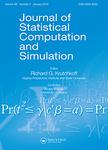版权所有:内蒙古大学图书馆 技术提供:维普资讯• 智图
内蒙古自治区呼和浩特市赛罕区大学西街235号 邮编: 010021

作者机构:Yunnan Univ Finance & Econ Dept Stat Kunming Peoples R China Southern Univ Sci & Technol Dept Stat & Data Sci Shenzhen Peoples R China Univ Hong Kong Dept Stat & Actuarial Sci Hong Kong Peoples R China Shenzhen Univ Coll Econ Shenzhen Peoples R China Shenzhen Univ Coll Econ Shenzhen 518055 Guangdong Peoples R China
出 版 物:《JOURNAL OF STATISTICAL COMPUTATION AND SIMULATION》 (统计计算与模拟杂志)
年 卷 期:2024年第94卷第2期
页 面:248-278页
核心收录:
学科分类:0202[经济学-应用经济学] 02[经济学] 020208[经济学-统计学] 07[理学] 0714[理学-统计学(可授理学、经济学学位)] 0812[工学-计算机科学与技术(可授工学、理学学位)]
基 金:National Natural Science Foundation of China Fundamental Research Funds of Yunnan, China [202301AU070085] Research Grants Council of the Hong Kong Special Administrative Region, China [HKU17306220]
主 题:Compositional inverse Gaussian distribution EM algorithm inverse Gaussian distribution zero-truncated product Bernoulli distribution >
摘 要:Compositional data (CoDa) often appear in various fields such as biology, medicine, geology, chemistry, economics, ecology and sociology. Although existing Dirichlet and related models are frequently employed in CoDa analysis, sometimes they may provide unsatisfactory performances in modelling CoDa as shown in our first real data example. First, this paper develops a multivariate compositional inverse Gaussian (CIG) model as a new tool for analysing CoDa. By incorporating the stochastic representation (SR), the expectation-maximization (EM) algorithm (aided by a one-step gradient descent algorithm) can be established to solve the parameter estimation for the proposed distribution (model). Next, zero observations may be often encountered in the real CoDa analysis. Therefore, the second aim of this paper is to propose a new model (called as ZCIG model) through a novel mixture SR based on both the CIG random vector and a so-called zero-truncated product Bernoulli random vector to model CoDa with zeros. Corresponding statistical inference methods are also developed for both cases without/with covariates. Two real data sets are analysed to illustrate the proposed statistical methods by comparing the proposed CIG and ZCIG models with existing Dirichlet and logistic-normal models.